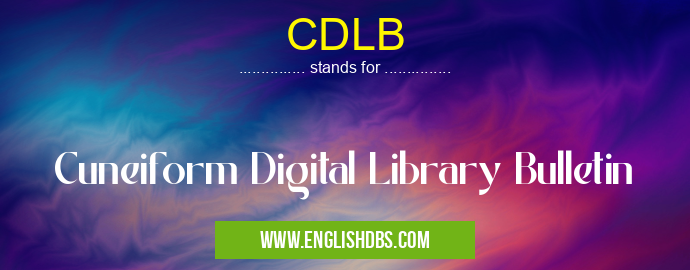What does CDLB mean in LIBRARIES
CDLB stands for Cuneiform Digital Library Bulletin. It is a peer-reviewed academic journal that publishes original research on the cuneiform script and its use in ancient Mesopotamia. The journal is published by the Cuneiform Digital Library Initiative (CDLI), a consortium of institutions dedicated to the preservation and study of cuneiform texts.

CDLB meaning in Libraries in Academic & Science
CDLB mostly used in an acronym Libraries in Category Academic & Science that means Cuneiform Digital Library Bulletin
Shorthand: CDLB,
Full Form: Cuneiform Digital Library Bulletin
For more information of "Cuneiform Digital Library Bulletin", see the section below.
Key Features of CDLB
- Open Access: All articles published in CDLB are freely available online without any subscription or registration requirements.
- Peer-Reviewed: All submissions undergo a rigorous peer-review process to ensure the quality and accuracy of the research.
- International Scope: CDLB welcomes submissions from scholars around the world, covering a wide range of topics related to cuneiform studies.
- Interdisciplinary Approach: The journal encourages interdisciplinary research that combines cuneiform studies with other fields, such as archaeology, history, and linguistics.
- Digital Humanities: CDLB promotes the use of digital tools and resources in cuneiform research, including the development of databases, online corpora, and digital editions of texts.
Essential Questions and Answers on Cuneiform Digital Library Bulletin in "SCIENCE»LIBRARIES"
What is the Cuneiform Digital Library Bulletin (CDLB)?
The Cuneiform Digital Library Bulletin (CDLB) is an open-access, peer-reviewed online journal that publishes original research on all aspects of cuneiform studies, including philology, archaeology, history, and digital humanities. It is a resource for scholars, students, and anyone interested in the study of ancient Mesopotamia.
What types of articles does the CDLB publish?
The CDLB publishes original research articles that make a significant contribution to the field of cuneiform studies. Articles may cover a wide range of topics, including:
- Cuneiform texts and inscriptions
- Mesopotamian history and archaeology
- Digital humanities and computational methods
- Philology and linguistics
- Epigraphy and paleography
- Art and iconography
- Religion and mythology
Who publishes the CDLB?
The CDLB is published by the Cuneiform Digital Library Initiative (CDLI), a consortium of institutions dedicated to the preservation and dissemination of cuneiform texts. The CDLI is based at the University of California, Los Angeles.
How can I submit an article to the CDLB?
To submit an article to the CDLB, please visit the journal's website: https://cdlb.ucla.edu. The website provides detailed instructions on the submission process, as well as the journal's submission guidelines.
How can I access the CDLB?
The CDLB is an open-access journal, which means that all articles are freely available online. You can access the journal's website at: https://cdlb.ucla.edu.
Final Words: CDLB is an essential resource for scholars and students of cuneiform studies. It provides a platform for the dissemination of new research, the advancement of knowledge, and the collaboration among researchers in the field. The journal's commitment to open access, peer review, and interdisciplinary perspectives makes it a valuable contribution to the academic community.
